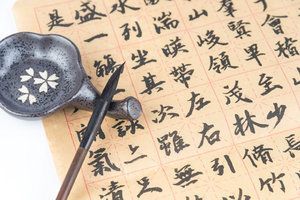TrA-2, my primary needle location, I needle 95% of the time and I think it works the best. You’ll know you have the right point location when you discover the muscle twitching when applying electric stimulation.
The Acupuncture Channel System (Part 1)
The earliest Chinese reference to channels is in the Mawangdui Medical Manuscripts,1 which are dated to the Warring States period of the Zhou Dynasty (475 BC-221 AD). The text presents 11 channels. There are no acupuncture points listed in those channels. The treatment methods are moxibustion and bloodletting; since there were no points, there is no acupuncture. It is commonly agreed that the Nei Jing (Internal Classic) was compiled during the Han Dynasty (206 BC-220 AD). The Nei Jing contains the Su Wen and the Ling Shu. There are no original versions of these two texts, as they were reconstructed at a later time. The Nei Jing marks a major shift in the practice of Chinese medicine. The major shift of the Nei Jing was its movement away from theurgic medicine: the belief in supernatural intervention as a cause of illness. Early Chinese healing included the belief in curse of the ancestors and ancestral medicine, and later ghosts and demons as causes of illness. The Nei Jing includes a deeper understanding of exogenous and endogenous pathogenic factors, lifestyle and the function of the human body.

The Mawangdui Medical Manuscripts include very general pathway descriptions of what we would call the primary channels. They are mostly pathways that flow on the superficial areas of the body; some channels connect to organs with no consistency, e.g., the concept of having connection to specific organs, or to what we now know as the Yin-Yang paired channels. The channels are defined more in line with what we know as the six channel pairs: Great Yang Channel, Minor Yang Channel, Yang Brilliance Channel, Shoulder Vessel, Ear Vessel and the Tooth Vessel.1
The Ling Shu (Spiritual Axis-Pivot) is considered the primary source for the practice of Acupuncture from the Han Dynasty. This book contains about 160 acupuncture points;2 the Mawangdui medical texts list no acupuncture points. The Nei Jing includes the primary channels, which are more detailed than the pathways found in the Mawangdui Medical Manuscripts. The Nei Jing also has more channels than the Mawangdui texts, which comprise a channel system. This channel system provides a road map of the human body.
The Nei Jing presents a channel system that can be viewed from the superficial to the deep layers of the body. The channels are the sinew channels, luo collaterals, primary channels, divergent channels and the eight extraordinary channels. Each of the channels more effectively corresponds to layers of the body, pathogenic factors, conditions, vital substances and anatomical structures. Treatment modalities also correspond more effectively with specific channel systems. This is a unique insight of the ancient healers and a key to clinical effectiveness. See the table in part two of this article for a summary of the channel system.
The Su Wen and Ling Shu Channel System
The Sinew Channels
This channel system is commonly known as the tendo-muscle channels. It is presented in chapter 13 of the Ling Shu, The Muscle Channels. This channel system is the most superficial of the channels systems listed. The chapter lists the signs, symptoms and conditions that correspond to these channels. They suggest using a hot needle for treatment. They also state each channel corresponds to a specific month of the year and that there can be imbalances of that channel during its associated month.
The sinew channels are used for musculo-skeletal conditions; with pain as the main symptom. Tui Na, bodywork, acupuncture, moxa, cupping, liniments and treating ashi points are traditional modalities. Electro-stimulation is a modern healing modality. Placing moxa on a needle is an alternative for a hot needle (warming the needle with fire).
The Luo Collaterals
The luo collaterals are primarily presented in the Ling Shu, chapter 10, The Main Channels, although they are also discussed in numerous chapters in the Su Wen and the Ling Shu. These collaterals are presented in a specific way in the Nei Jing. The treatment method for the luo collaterals is bloodletting on the luo point or along the luo collateral (the actual pathway).
The Nei Jing states that the luo collaterals can be seen while the primary channels cannot be seen. The luo collaterals have no pulse while the primary channels have a pulse. The luo collaterals have colors and specific pathogenic factors. Visual inspection of the luo is a key to diagnosis; there are signs and symptoms that are organized into deficiency and excess conditions of the luo. These collaterals are presented as buffers to hold pathogenic factors to prevent them from flowing deeper into the body and the channel system; bleeding is used to release the pathogens. They are located at the superficial layer of the body and the treatment method in turn treats the superficial layer. [See the my articles in the June, July and August 2015 issues of Acupuncture Today for a historical view of the changes in the clinical applications of the luo collaterals.
Editor's note: In the next issue part two will resume with the primary, divergent and eight extraordinary channels.
References
- Harper D. The Mawangdui Medical Manuscripts. London: Kegan Paul International, 2007.
- Wu J. Ling Shu or The Spiritual Pivot. Hawaii: University of Hawaii Press. 2002.
- Twicken D. The Divergent Channels, A Handbook for Clinical Practice and Five Shen Nei Dan Inner Meditation. London: Singing Dragon, 2014.



